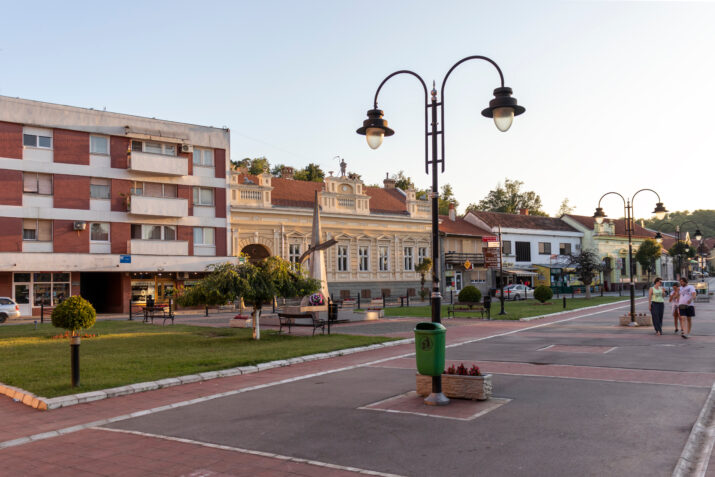

In this article, the concept of placemaking is approached from the perspective of the benefits to local communities and the ways in which students in architecture and planning learn about it. At the Faculty of Architecture at the University of Belgrade, students often work together on studio projects to solve issues of spatial use and function in specific and predefined areas. Placemaking is a rather new concept in the field of architecture, urbanism, and policy-making in Serbia, and it has been applied there in various ways. There are many ways to “make a place.” Places can be made from the bottom-up, for example when a resident builds a small garden, or from the top-down, when a set of specific activities are imposed on a local community by the government. Since the 1990s, the concept of placemaking has been adopted and accepted by many planning theorists and practitioners in Serbia as a solution to a growing number of conflicts among interest groups over urban development (Milovanovic-Rodic and Maruna 2022). Placemaking has been seen as a tool for enhancing the identity of places, cities, and citizens. It has also been seen as a way to improve quality of life and urban planning projects more generally.
Today, higher education faces various challenges, and educators have struggled to devise innovative teaching methods. Architects, urban designers, planners, and landscape architects play a crucial role in shaping the living environment for future generations. Therefore, it is important to integrate placemaking pedagogy when educating students. It is also key for educators to use creative and comprehensive methods to instill a sense of identity in students and encourage them to engage with the environment by combining modern technologies and traditional teaching practices. Moreover, in a time of social division, it is vital to foster collaboration in the planning process by exposing urbanism students to a diverse range of voices, including radical ones. The flexibility of curricula can be used to cater to the learning needs of students and engage them in creative practices that enhance spatial literacies (Djukic and Vukmirovic 2012). It is indeed possible to develop themes across the urbanism and architecture curriculum based on the principles of urban design, which integrates collaboration, consultation, spatial literacy, community participation, and social justice (Fisher 2004).
At the Faculty of Architecture at the University of Belgrade, various courses in urbanism have integrated placemaking as a topic since 2003. Students are exposed to the concept during their third semester and continue to use it until they finish their studies. Students learn about placemaking and urban design through theoretical courses, studio projects, seminars, and workshops. To develop their understanding of placemaking, students engage in collaborative planning and co-creation through studio projects, which are usually connected to a local community, local government, and stakeholders. In the past, these projects have been based in Belgrade, but increasingly they have also involved small and mid-sized towns across Serbia.
Students enrolled in the “Integral Architecture Program” at the University of Belgrade can conduct a studio project in urban design and planning. These students must produce a design project as the final outcome of the course. Students select a town and focus their research and design on its historic center. The studio curriculum is divided into three interconnected courses: “Studio Project,” a theoretical seminar, and a workshop. “Studio Project” constitutes the main course and where students design their urban and architectural projects. The seminar entails deepening students’ theoretical knowledge, so they can elaborate on the possible implementation of sustainable solutions when designing their urbanism projects. They can also participate in various workshops—“building camps”— to build elements for urban parks. Workshops are also where students evaluate their final projects based on criteria used in assessing the quality of open space in cities. The main objective of the Studio Project course is to teach students about innovative methods in urban design and planning. In the course, they engage in concrete tasks aiming at regenerating parts of an urban fabric that may have been devastated. The studio allows students to examine contemporary urban concepts used in the process of urban regeneration and renewal and learn possible applications of these concepts to concrete urban situations.
Hence, the Studio Project course is practice-oriented but is nonetheless based on the theoretical background taught in the seminar “City and Design,” a compulsory course in which students learn about contemporary urban concepts in urban regeneration and renewal. Studio work is then divided into two parts: research and design. The research part is conducted both in person on site and on the web and entails the examination of the literature and web-based sources. The outcome of the design part is an urban design project that includes conceptualization, modelling, and programming. The course also includes lectures through which students acquire specific skills about how to (1) obtain the data they need through indirect, albeit effective techniques (2) use urban modelling to re-evaluate the design process. These skills also help students overcome psychological barriers they may encounter in the design process and support them in their creative and innovative thinking. In addition to these practical skills, students acquire professional skills and transversal competences.
When conducting their research, students primarily conduct an in-depth analysis of planning of documents. Subsequently, students engage in research on the specific location they chose. This research includes on-site visits, interviews, questionnaires, and interactions with citizens. This phase often also entails meeting with stakeholders and local government officials. Back in the studio, students use brainwriting, superhero, and lotus techniques to exchange ideas and collaborate to create solutions to the problems they have identified. This collaborative process unfolds in two stages: conceptual design and program development. Two key methodologies are applied in the design studio. First, The “Kevin Lynch” method is used. It involves formulating questionnaires based on Lynch’s “Image of the City” method, which entails conducting on-site surveys and creating visual aids to be later discussed. It focuses on sense of place, memory, and identity. Second, the space syntax method is used to assess how many people use a space and the activities they conduct there. Students also conduct an analysis of the strengths and weaknesses of their projects, as well as opportunities and threats these projects present (SWOT analysis) and cross-check this assessment with their findings through the space syntax analysis. The research findings are compiled into a comprehensive report, which details the main outcomes and implications of each project. Subsequently, students develop a conceptual urban design model, which is presented to citizens through workshops or exhibitions. If the community approves the conceptual design, students proceed to refine and finalize it.
The specific objectives of the Studio Project are as follows:
- Enhance students’ creativity in urban planning and design by teaching them collaborative techniques such as space syntax, brainwriting, the super-hero technique, or urban modelling;
- Engage students in multi-phase active learning, alternating individual and group work;
- Expose students to innovative and alternative methods and techniques that can initiate, motivate, and facilitate the processes of urban design and planning;
- Teach students that re-evaluation is a precondition of successful urban design and planning when faced with the challenges of a complex urban future; and
- Provide students with the opportunity to present quality studio work that can trigger the collaboration of local experts and populations in city and town development.
Students learn to identify different dimensions of development policies (social, economic, environmental, or cultural). They also learn to develop comprehensive urban design projects using different media and tools and make creative use of visual techniques used in urbanism. They also dialogue with stakeholders from local communities. Hence, students come to understand that context matters in its economic, social, political, organizational, and physical dimensions and learn to adapt to change, which will be useful in any future professional work (Harmanescu, Mihaila, et al. 2023).
Architecture students working in Golubac
Between 2017 and 2020, students from the University of Belgrade were involved in the INTERREG Danube Project DANUrB, which continued as INTERREG project DANUrB+ between 2021 and 2023. The focus of the project was Golubac, a small town with a shrinking population along the Danube, situated near the entrance of the Iron Gates Gorge and bordering the Djerdap National Park. A medieval fortress is located nearby, which was recently renovated with funding from the European Union. The town sits at the border of Serbia and Romania and particularly suffered while Serbia was isolated from the international community after the collapse of the socialist economy in the 1990s and 2000s. During that time, the economy of Golubac was devastated, especially its core sectors—industry and tourism. The town also lost more than 15 percent of its population between 1991 and 2011, as young and educated people left. The Golubac municipality was even added to the list of “devastated areas” in Serbia, i.e., those municipalities with a GDP below 50% of the national average. Among other issues, the town’s development funds have not made it possible to answer the needs of the town’s residents. Golubac does not even have the capacity to accommodate and retain tourists who come to visit the fortress.
One of the objectives of the INTERREG DANUrB project was to strengthen the capacities of towns to develop and build a network of communities for future collaboration. The collaboration between the Faculty of Architecture and the local community in Golubac resulted in dozens of workshops, interviews, and an exhibition of students’ projects about how to develop the town. It also resulted in a competition for the best postcard; these postcards were produced by architecture students. The project also resulted in an “Action Plan” for future development and a pilot project that consisted in a small-scale architectural project for the local community. Other outcomes were a digital platform and mobile applications—”Pocketguide.” This digital platform is an inclusive online communication tool containing data about different stakeholders and the products and services they offer. It also contains information about the tangible and intangible cultural heritage located in the town. The Pocketguide application proposes tours of the town and informs tourists about unusual and forgotten heritage places, such as those that emerged during the socialist period. Two of the most important outcomes of the INTERREG DANUrB project have been the analogue “Atlas of Hidden Values of the Danube Region” and an interactive digital atlas, which both educate people about and promote the Danube region. Both present the history of development in the region’s towns and plans for future development there.
In the “building camp” workshops, students materialized and actually built a small-scale urban design project on site based on choices made by the local community. Students who had volunteered to participate in the camp worked and lived with local residents on a short-term basis; and residents were not paid to host them. Initially, in late 2021 and early 2022, meetings with local representatives and project leaders from the University of Belgrade were organized. During that time, several possible sites in the town were identified, as to offer students an array of sites from which to choose. At the beginning of the building camp, students conducted on-site surveys and organized a workshop with citizens, experts, and stakeholders in Golubac. They also used questionnaires and interviews. The specific location selected for the collective project was an area along the Danube waterfront, which was at the time completely covered with bushes and would be transformed into a park through the project. Before getting to the site, students made small-scale models of urban furniture they wanted to install there; these would be later realized A series of playful and colorful urban furniture were added to the new park. Despite the financial constraints the town faced, the students were able to build amenities by creatively utilizing recycled materials and repurposing existing infrastructure. They rejuvenated the waterfront location demonstrating resourcefulness and a sustainable approach to design. Thus, the Building Camp was effective at teaching students about participatory processes and at improving their democratic awareness, mutual understanding, increased independence, and self-reliance. In Golubac, community engagement was central to the success of the building camp workshop. Residents actively participated in the process, which ensured that the new city park the students designed reflected the community’s identity and aspirations. The collaboration between students and residents led to the transformation of the waterfront area into a vibrant, inclusive space and stands as a good example of successful placemaking. The project’s success underscores the significance of community involvement in urban renewal projects and proposes various ways of engaging architecture students in placemaking. The outcome of the pedagogical approach used at the School of Architecture at the University of Belgrade provides insights into the future of placemaking. Students there have been successful at developing and implementing different digital tools to enhance the overall development of small and medium-sized Serbian cities in the face of depopulation.
Aleksandra Đukić is Full Professor at the University of Belgrade – Faculty of Architecture, Department of Urbanism. Her professional activities and research pertain to urban design and planning, urban morphology, urban renewal, and heritage. She is the vice president of the Town Planning Association of Serbia and represents Serbia at the European Council of Spatial Planners and the Association of European Schools of Planning.
Jelena Maric is Associate Professor and Vice Dean for Quality Assurance and Cooperation with the Public Sector at the University of Belgrade – Faculty of Architecture, Department of Urbanism. Her fields of interest are urban design, sustainable development, and public health.
Branislav Antonic is Assistant Lecturer at the University of Belgrade – Faculty of Architecture. His fields of interest are urban planning, urban governance, and shrinking cities. He has published multiple papers and he is active in the Town Planning Association of Serbia.
References
Djukić, Aleksandra. 2021. Oblikovanje javnih prostora [Urban Design of Open Public Places]. Belgrade: Univerzitet u Beogradu – Arhitektonski fakultet.
Djukić, Aleksandra and Vukmirović, Milena. 2012. UrbanLab Beograd 2020 – kulturna prestonica Evrope (UrbanLab Belgrade 2020 – the cultural capital of Europe). Belgrade: Faculty of Architecture.
Fisher Robert. 2004. “What is Creativity? “. In Unlocking Creativity: Teaching Across the Curriculum edited by Robert Fisher and Mary Williams, 6-21. New York: David Fulton Publisher.
Harmanescu, Mihaila, Stan, Angelica, Vasile Manea, Sorin (Editors). 2023. Methodological guidelines and new theoretical and practical methods of interdisciplinary teaching for assessing small and medium sized cities on Danube. Bucuresti: Editura universitara “Ion Mincu.”
Milovanović-Rodić, Danijela and Maruna, Marija. 2022. “Кolaborativni pristup za utvrđivanje i odbranu javnog interesa u neoliberalnom, politizovanom i polarizovanom urbanom pejzažu” [A collaborative approach for establishing and defending the public interest in a neoliberal, politicized and polarized urban landscape]. In U potrazi za javnim interesom: dometi urbanizma, [In search of public interest: the scope of urbanism] edited by Danijela Milovanović Rodić, Ljubica Slavković, Marija Maruna, 64-83. Belgrade: Univerzitet u Beogradu – Arhitektonski fakultet.
Pušić, Ljubinko. 2001. Održivi grad: ka jednoj sociologiji okruženja [The Sustainable City: Towards a Sociology of the Environment]. Belgrade: Slobodan Masic.
Photo: Shutterstock | Golubac, Serbia – AUGUST 11, 2019.
Published on June 17, 2024.




